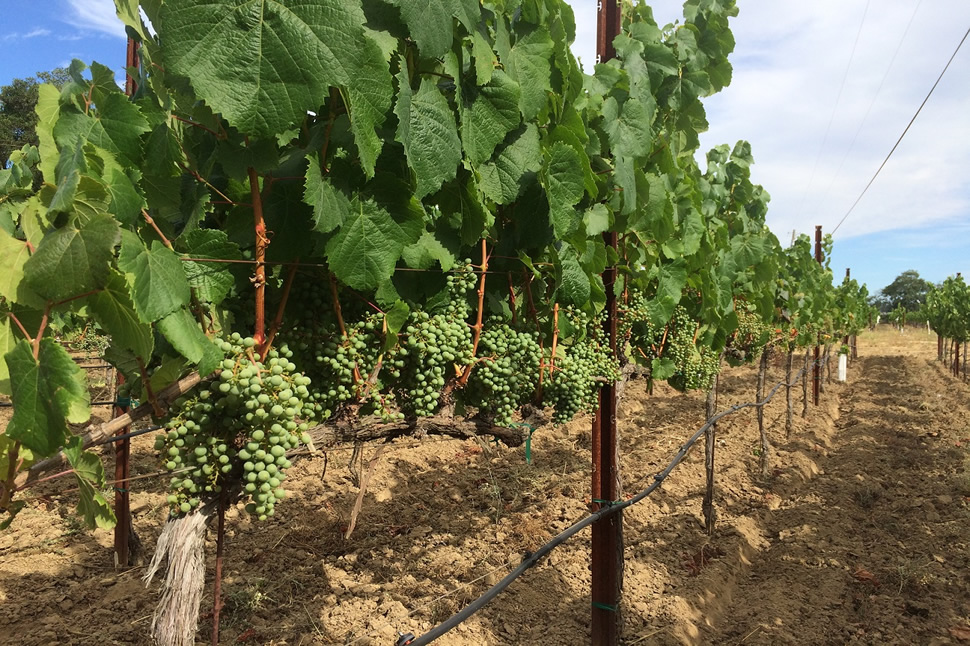
Vineyard picture 7/7/15. M.H.

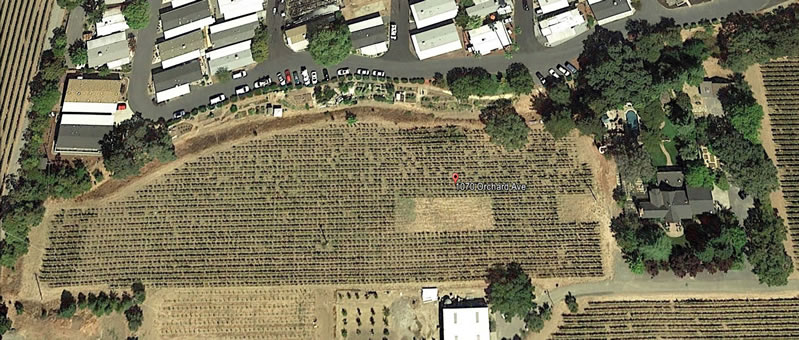 South >>
South >>
2.05 acres (without avenues or Septic), 2960 vine locations, 6'x5' spacing. Approximately 200 vine locations recently replanted with clone 596. 4/22/15
Malbec, probably clone 596 but may be clone 9 on 101-14 rootstock. Unilateral cordon VSP.
Below is information shared by Doug Hill, the prior vineyard management company.
Originally planted by Brecon Jackson ~2005. Farmed by Doug Hill 2012-2014.
The fruit in the last 3 years was used by the Hill Family Estate in their Malbec wine, 200 case production. The fruit was blended at the crusher with other Malbec grapes from Napa valley. 200 case production is inconsistent with 7 tons of fruit.
3/29/14 Talked with tenent Cathy and was able to view water system infrastruture on the site. Developed the water system schematic below.
In row valves to isolate extra vigorous vines on the North end.
No Soils data, May have some petiole analysis.
2012-2014 Fertigation Potassium at start then Triple Mix 15-15-15 later in season.
Vines are generally low vigor.
No problems with neighboring residents through 2014
| Year | Yield Tons. | Tons/Acre | lbs/vine |
|---|---|---|---|
| 2012 | 7.51 | 3.66 | 5.54 |
| 2013 | 6.51 |
3.17 |
4.80 |
| 2014 | 7.57 |
3.69 |
5.58 |
| Average | 7.2 | 3.50 | 5.3(~16 clusters/vine) |
Above based on 2.05 acres, 2710 producing vines.

Irrigation Schedule for Landscape and Vineyard extracted from Hunter Controllers 7/7/15 M.H. is shown below. After reviewing this schedule we have concluded that most of the water use for the site, approximately 5000 gallons/day is being used to irrigate the landscape. Most of the water use is between 7:00pm and 6:00am when the residents are using little water and the irrigation timer schedules show that water is being used to irrigate the 21 different circuits covering the landscape. See schedule below. The schedule shows the irrigation durations but, provides no indication of the volume being used by each block since the flow rates are unknown. A water meter would need to be installed on the domestic water system outflow to capture that information. There are likely opportunities to reduce water use on the landscape.
| North Landscape, Hunter controller by vineyard | South Landscape, Hunter Controller in Garage | ||||||
Schedule A, Start: 2:00am, Days: MTWThFSn |
Duration (min.) | Schedule B, Start 2:00pm Days: W,Sat | Duration | Schedule A, Start: 7:00pm Days:MWThFSn | Duration | Schedule B, Start: 12:00am Days: TWFSat | Duration |
| 1 | 20 | 0 | 22 | ||||
| 2 | 20 | 0 | 22 | ||||
| 3 | 20 | 0 | 22 | ||||
| 4 | 25 | 40 | |||||
| 5 | 25 | 42 | |||||
| 6 | 37 | 42 | |||||
| 7 | 39 | 45 | |||||
| 8 | 30 | 46 | |||||
| 9 | 30 | 30 | 15 | ||||
| 10 | Vineyard East | 240 | 0 | 30 | |||
| 11 | Vineyard West | 240 | 9 | ||||
| 12 | 20 | 0 | |||||
| Total One Day Run Time: | 4:26 | 8:00 | 4:14 | 1:51 |
Well water quality looks excellent and the water meter on the tank indicates 460K gallons have been pumped from the well since August 2014 which is a substantial volume. The Vineyard is expected to use roughly 60 gallon/vine times 3000 vines = 180K gallons.
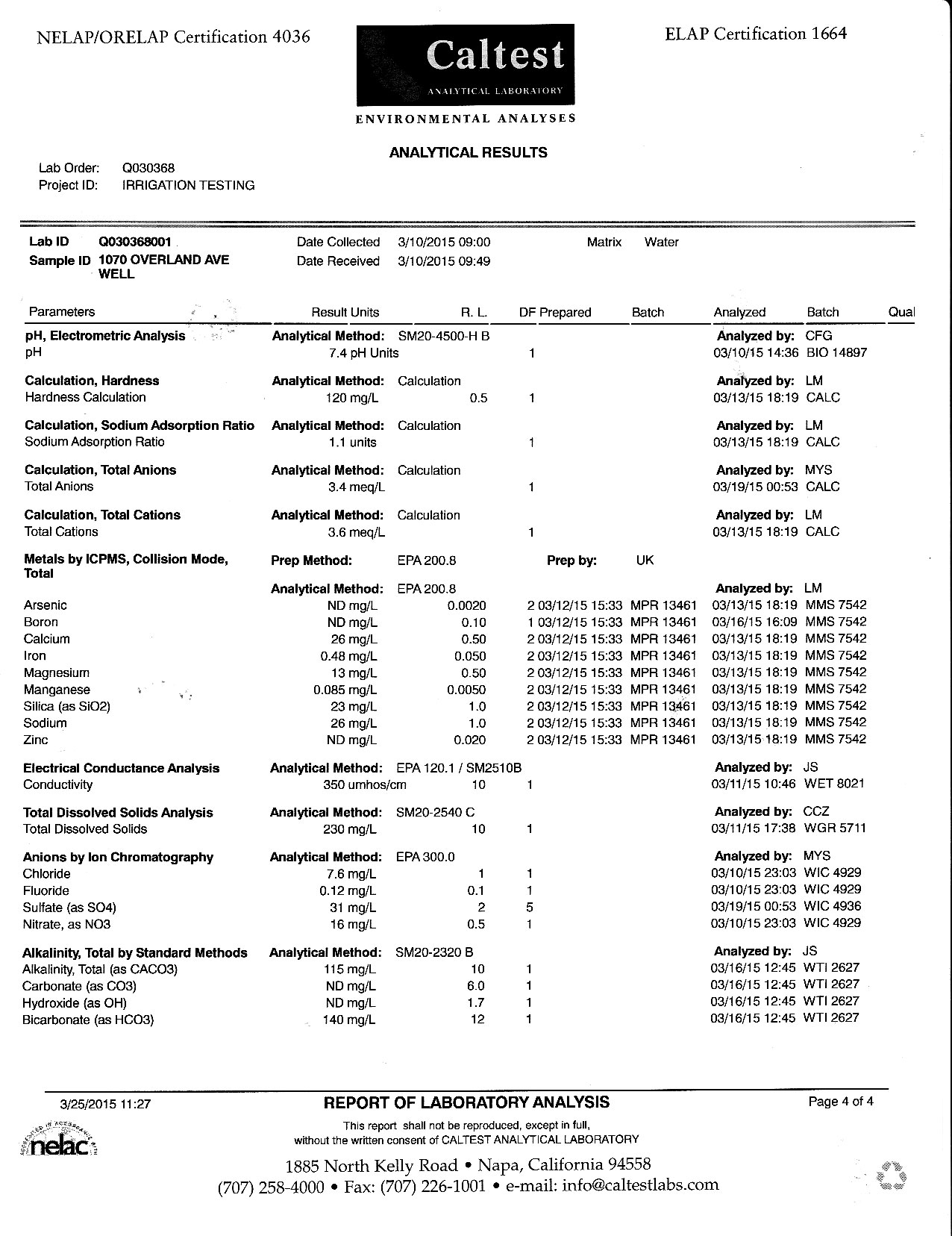

Note: The report above is for the well at 1070 Orchard Ave. not Overland Ave. This error is due to a handwriting misread.
Water source, well in the front center hedgerow straight out from the front door. The well is the only water source and pumps to a 10K gallon tank. The neighbor has a city water hookup according to Cathy. Herardo Ayala does the Landscape maintenance. McClean and Williams installed and maintains the system although Imboden has done some work on it. See schematic below. The water system sustained damage during the earthquake 8/14. During the repairs a meter was added to the large tank fill line. That meter read 463,690 gallons on 3/26/15. If the meter read zero when installed this would indicate 76,000 of water use per month although it is likely water use was higher duirng September and August while the vines were still needing irrigation. This corresponds to a pumping rate of 1.8 gallons/minute for this period of 6 months. Its safe to say the well recovery rate is in excess of 1.8 gpm.
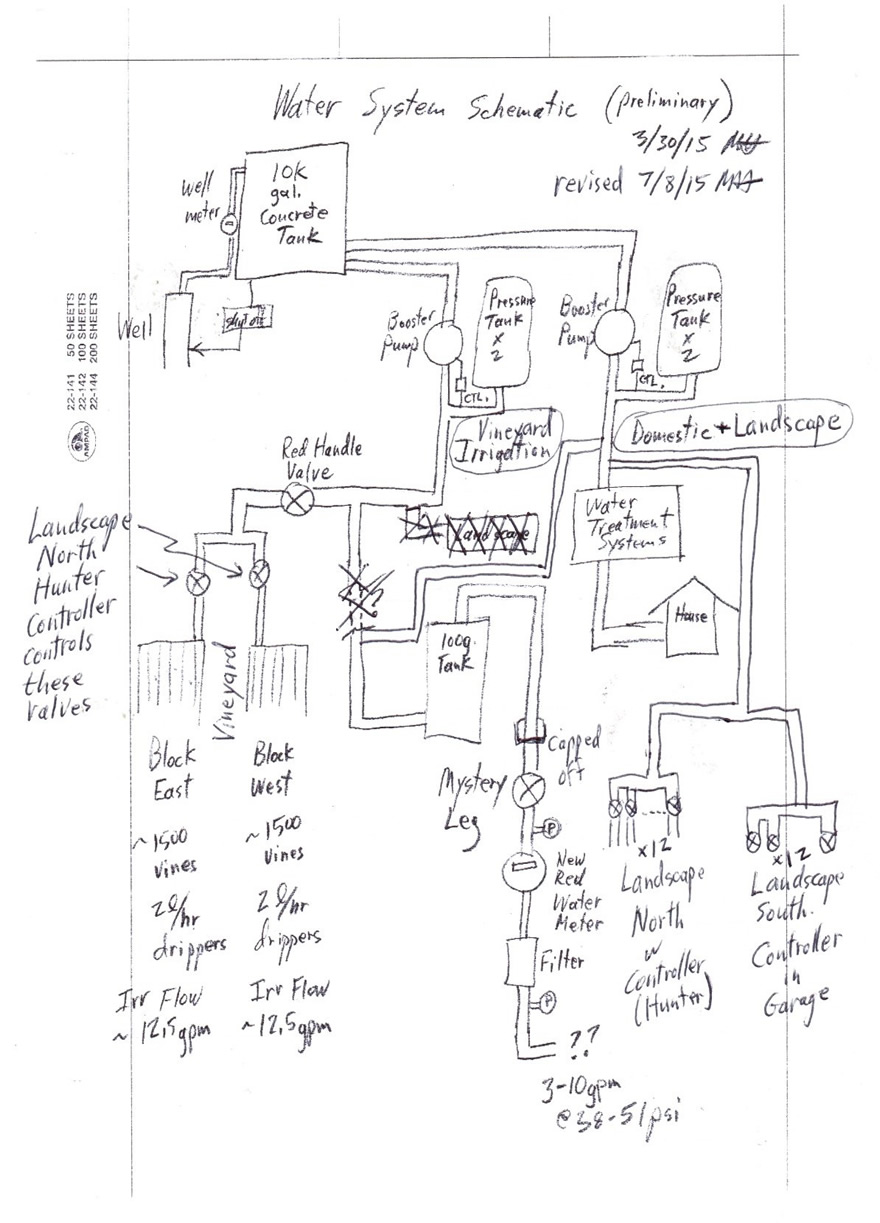
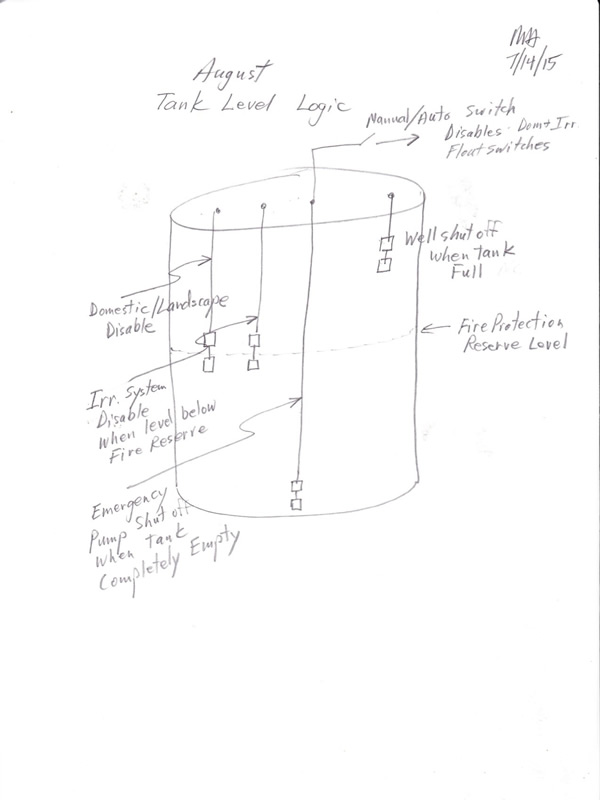
Irrigation recent years, 4 gallons/week June-September translates to ~200K gallons/year total, 64 gallons/vine.
The meter was apparently installed after the Napa Earthquake on August 23, 2014. Presumably the meter read zero at that time 6 months ago. This gives a first order indication of the volume the well is capable of producing. It is more than double the anticipated needs of the vineyard which is great if it is confirmed.
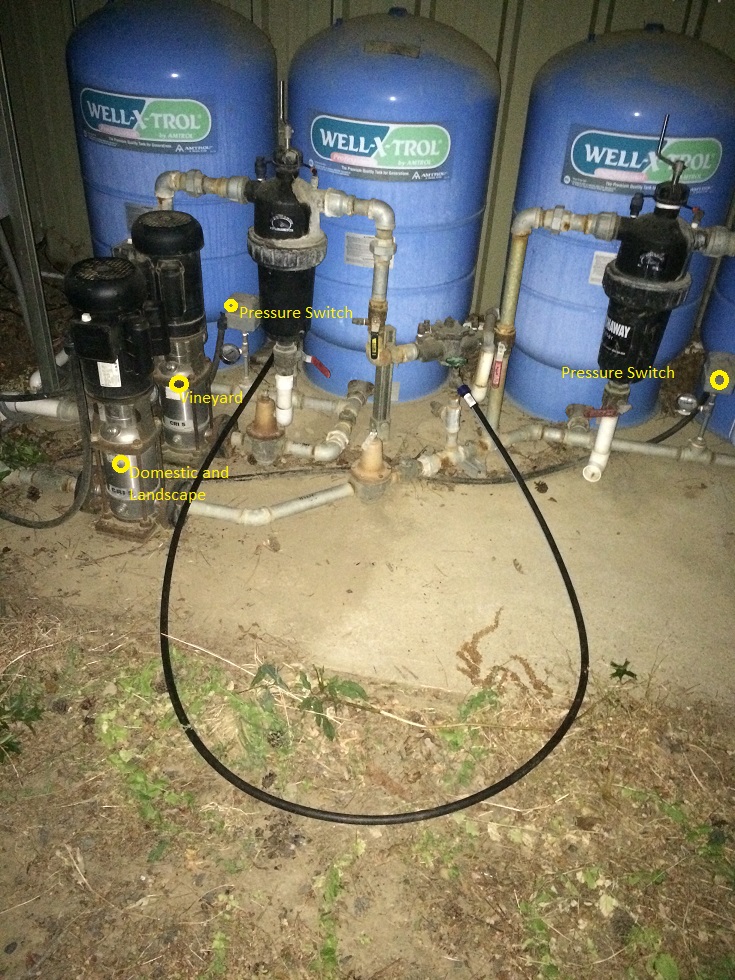
Note: their are two pressure systems which provide some nice redundancy. The crossover hose shown can be used to provide water from one system to the other if one should fail.
Below you can see the two booster pump relays. The one of the left is for irrigation and the one on the right is for the domestic/Landscape system. Note the relay on the right is a replacement. Also note the emergency manual overide switch in the lower right of this photo. This switch when switched to the manual position turns on the Domestic/Landscape system if the tank is empty or if the tank level indicator isn't working. It is a quick way to get water pressure to the house if the tank level sensor isn't working and there is still water in the tank. However, leaving the switch in the manual position with the tank empty will burn out the pump and/or may result in an overpressure situation in the system.
7/13/15 I climbed on top of the tank and looked down in with the lid off and was able to take the photo below which shows FOUR float switches in the tank. There are two float switches in the lower left of the photo tethered about half way down inside the tank which are likely there to shut off the two pressure system pumps if the tank level drops below the level required for fire protection. The float switch on the right shuts off the well when the tank is full. Note reflection of moron in need of a life taking the photo.
The 4th float switch in the upper left is tethered closest to the bottom of the tank and is labeled "emergency". I believe this is the fail safe that shuts down the pumps before the tank goes completely empty if the two float switches higher up are disabled. If the manual/auto switch is set to manual I believe the system ignores the two float switches tethered higher up and lets the home owner use the fire protection reserve in an emergency like the vineyard irrigator turning on the vineyard irrigation for too long. Note: however, that the landscape irrigation will flow from the fire protection reserve as well as the domestic use if the landscape irrigation timers are not switched off in this emergency use scenario.
Below is a photo of the wiring to the float switches. Note they are all switching 110V and can easily electrocute an unsuspecting repair man especially if there is an unexpected fault in the insulation. This photo also shows the only documentation I have been able to find thus far. Auto vs. Emergency float switches are labled. Based on the the age of the emergency float switch wiring I would guess that the domestic pressure system has been dropping out due to tank overdraws for decades and was addressed by the addition of the emergency float switch some time ago.
The very important discovery here is that anytime the residence loses water pressure but the tank is still 1/3 to 1/2 full pressure can be quickly restored by flipping the auto/manual switch to manual. However the fire protection reserve will be used and the landscape irrigation will continue to use the fire reserve water too. It's not a good solution but, with no control over water use or early warning of tank level getting marginal it's the best they could do.
I am not sure that the float switches are all working as they should. Some evidence of this is that the tank went completely empty without the switch being switched to manual. The fire protection level switches may have been disabled or have failed as shorts.
Note in the picture above you can see water from the well flowing into the tank and splashing. The water in the tank is very clear and not much sediment was visible on the bottom of the tank.
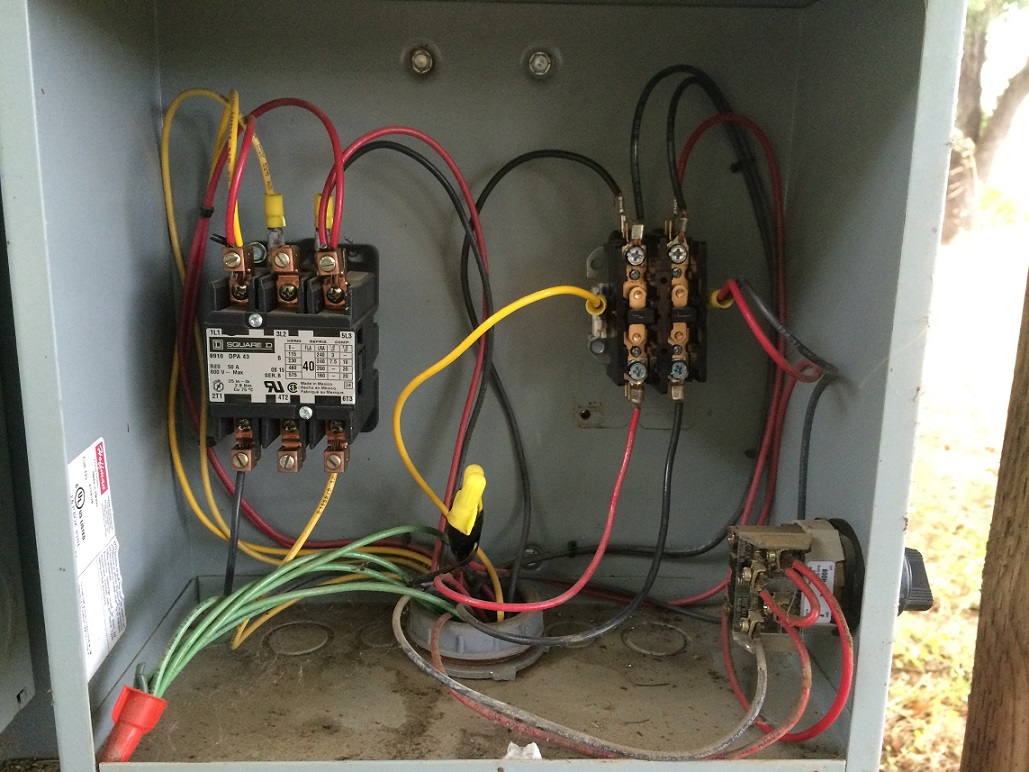


Below is the wireless tank level sensor installed 7/13/15. Note the actual ultrasonic sensor in the lower right of the tank opening. Designed built and installed by Camalie Networks.
Last Updated 7/13/15 by Webmaster Mark Holler - Pulido Vineyard Management